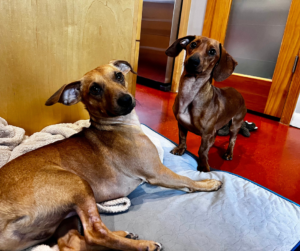Michael Baugh CDBC CPDT-KSA
The process is simple. The project sometimes feels hard.
This is how we humans get tripped up. We focus too much on the dog training project, what we have to accomplish, the end goal. We lose sight of – or never get a clear picture of – the process of how to train our dog.
Anything our dogs can physically do, we can teach them to do it on cue. Lie down, relax the hips, rest the head on the front paws. Those are all trainable. We can even teach them to breathe slower. Go to another room. Wait quietly behind a baby gate. Those are teachable too, with positive reinforcement training.
The process, the actual science of dog training, is very accessible to humans with average intelligence and education. (Most of you reading this are well above average). Still, when we face a dog who is biting, barking, or just going bonkers, it can all feel like too much. I get it. No, really, I do.
 Besides Charlie, who we’ve had just a few months, we also have a year-and-a-half old foster dog, Norman. I want them to behave nicely in the house. I want them to pee and poop outside. I want them to get along well with each other. When I look at those big, admittedly vague, project goals, I feel anxious.
Besides Charlie, who we’ve had just a few months, we also have a year-and-a-half old foster dog, Norman. I want them to behave nicely in the house. I want them to pee and poop outside. I want them to get along well with each other. When I look at those big, admittedly vague, project goals, I feel anxious.
When I look at the process, I breathe easier. When I actually start the process, none of it feels hard at all. Teach coming when called. Teach a relaxed down. Potty train. Monitor body language during play. Cue breaks in play. My training sessions with each dog are short, seven to ten minutes. I train one to two times daily, per dog. That’s it.
Our results have been fast and measurable, so far. My worry about big-picture outcomes (yes, I’m a worrier) reduces notably with each session.
Certainly, I don’t expect my clients to know training processes right off the bat. Teaching those is my job. New trainers also don’t automatically have great timing and mechanical stills (When do I click? When do I give the treat?). Teaching that is also my job. And it’s normal to feel some frustration along the way. You guessed it. Coaching my human clients through that is my job, too.
Bottom line: Set goals. It’s good to know what we are reaching for. Then, set those goals to the side and focus on the process. The destination is not the thing. Getting there is the thing.
Michael Baugh teaches dog training in Houston, TX. He specializes in aggressive dog training.
